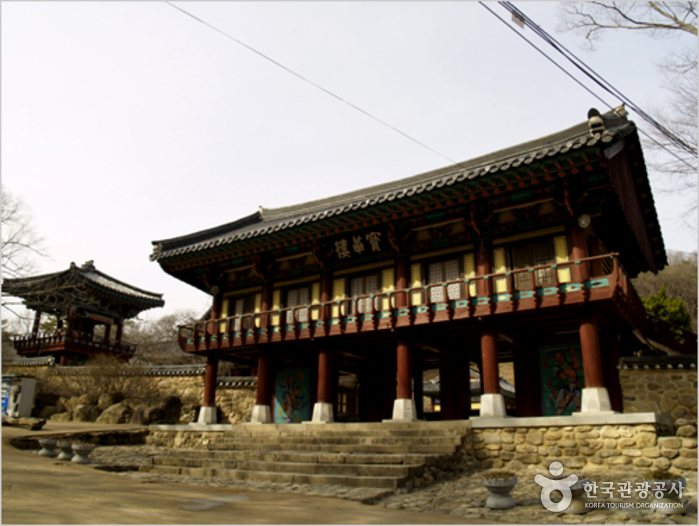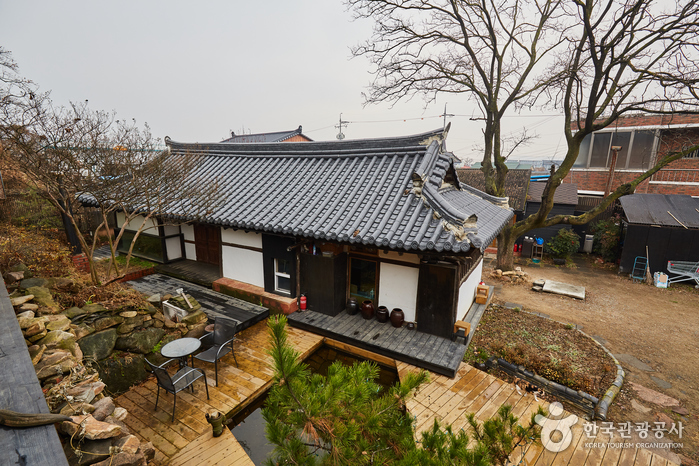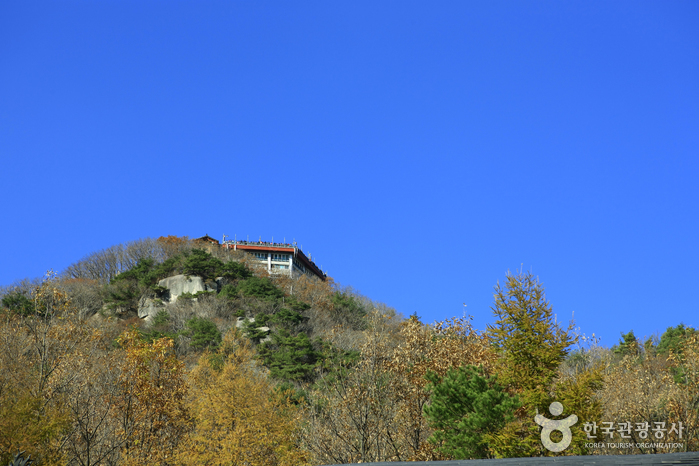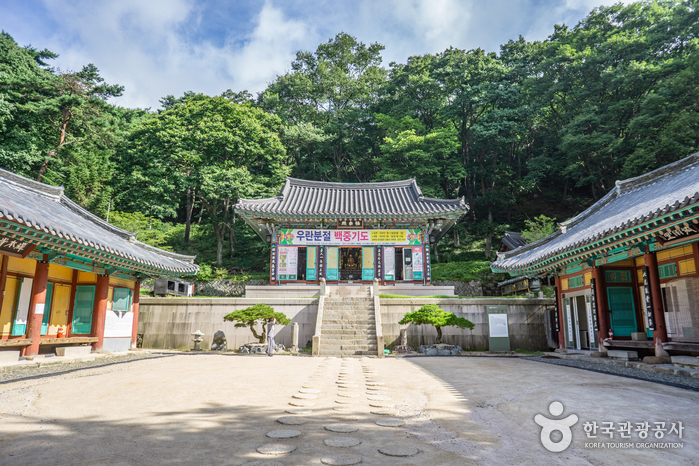Yeongcheon Eunhaesa Temple (은해사 (영천))
11.4Km 14367 2021-12-21
951, Cheongtong-ro, Yeongcheon-si, Gyeongsangbuk-do
+82-54-335-3318
Eunhaesa Temple, located on Palgongsan Mountain in Yeongcheon city, Gyeongsangbuk-do, is one of two major temples on the mountain along with Donghwasa Temple.
The temple was founded by Monk Hyecheol and was given the name Haeansa Temple in the first year of King Heondeok’s reign during the Silla Kingdom (AD 809), but was moved to the current site in the Joseon dynasty in 1546 (the first year of King Myeongjong). Upon its relocation, King Injong of Joseon dynasty was commemorated with a new lecture hall along with a memorial stone plaque where the king's umbilical cord was buried and sealed. It was then when the temple was also given its current name, Eunhaesa Temple.
The temple houses the main shrine, Bohwaru pavilion, Seolseondan Hall, Shimgeondang Hall, eight small hermitages, as well as Baegeungam Temple, Jungangam Temple, and a professional Buddhist education institution, the Eunhaesa Buddhist University. Eunhaesa Temple is home to a National Treasure, Geojoamyongsanjeon Hall, and Treasure, Baekheungamgeukrakjeon Hall. It also contains Treasure, the Sunidan Buddha Platform; Treasure, the Wunbuamcheongdongbosal Seated Buddha Statue; and Treasure, the Eunhaesa Temple Gwaebultaeng hanging Buddha picture. The area is also close to the Seongbu Museum, which exhibits cultural assets from Eunhaesa Temple and the neighboring areas, as well as popular tourist attractions such as Geukrakgul grotto of Jungangam temple (Hwaeomgul Grotto), Geondeul Rock, Manyeonsong Pine Tree, Ganggunsu Waters, and Anheungpokpo Falls of Gigiam Temple.
Asamgong
12.1Km 8781 2021-04-09
5-5, Sawol 1-gil, Namsan-myeon, Gyeongsan-si, Gyeongsangbuk-do
+82-10-2541-1284, +82-10-4787-3314
Located in Sawol-ri, Namsan-myeon, a place known for its beautiful sandy beach, the guesthouse ‘Beautiful Life’ was built by architect Kim Gyeong-ho, and is composed of 100-year-old-hanok buildings and a courtyard with a large sophora. Designed to provide guests with a “beautiful life”, it provides both accommodation services and diverse cultural programs including exhibitions, performances, and movie screenings.
Beautiful Life was conceived as a cultural tourism space set amid quiet countryside where guests can relax by enjoying exhibitions and performances, reading a book, listening to music, or getting lost in thought amid the serene atmosphere of the house. The owner transformed the abandoned house into a beautiful hanok stay after falling under the charm of the quiet location and the old house with its beautiful old tree and well.
The guestrooms include Jewoldang, Yeorakdang, Uiyeoldang, and Heosimjeong. The first of these is a 100-year-old hanok structure with a tiled roof, which can be rented in its entirety. Its name, Jewoldang, roughly means “a place to pick up the moon” because the moon is visible above the sephora in the courtyard from the daecheong (wooden floor) on bright moonlit nights. Its ‘ㅡ’-shaped structure and ceiling rafters are original features of the old hanok, while the kitchen and bathroom were entirely renovated, as was the attic on the second floor, lending a special atmosphere to the house.
As for the Yeorakdang, which means ‘a house to enjoy together,’ it was converted from a storeroom for apples into a building that can accommodate groups of guests and also screen movies. The Uiyeoldang, meaning ‘a house to discuss and study together,’ was built by transforming the haengrangchae (servants’ quarters) and the stable into a reading space and a seminar room, respectively. Finally, the Heosimjeong, meaning ‘a pavilion where one can empty one’s mind’, is the ideal place for relaxing in small groups. Each of these four buildings is built in a modern style with wooden materials, glass windows, and staircases. There is also an outdoor stage equipped with a sound system for special performances.
Olive Young - Gyeongsan Market Branch [Tax Refund Shop] (올리브영 경산시장점)
13.3Km 0 2024-06-27
78, Jungang-ro, Gyeongsan-si, Gyeongsangbuk-do
-
Palgongsan Provincial Park (Gatbawi Section) (팔공산도립공원(갓바위지구))
13.6Km 27396 2021-03-04
Wachon-myeon, Gyeongsan-si, Gyeongsangbuk-do
+82-53-981-6406
Located north of Gyeongsan, Palgongsan Mountain (altitude 1,192.3 meters) was called both Jungaksan and Buaksan Mountain during the Silla period. The mountain has many ancient temples and historical sites such as the Gatbawi Stone Buddha, Wonhyosa Temple, Cheonseongsa Temple and Bulgulsa Temple.
E-Mart - Gyeongsan Branch [Tax Refund Shop] (이마트 경산)
13.6Km 0 2024-04-17
227, Oksan-ro, Gyeongsan-si, Gyeongsangbuk-do
-
ER NC Department Store - Kyungsan Branch [Tax Refund Shop] (ER NC백화점 경산)
13.7Km 0 2024-04-18
39, Jungang-ro, Gyeongsan-si, Gyeongsangbuk-do
-
Gyeongsan Seonbonsa Temple (선본사(경산))
13.7Km 13626 2021-12-02
699, Gatbawi-ro, Gyeongsan-si, Gyeongsangbuk-do
+82-53-851-1868
Seonbonsa Temple is a centrally administered temple of the Jogye Order. It was originally built in 491 by Geukdal, and later repaired in 1641. The temple is home to many important cultural treasures, including the Stone Seated Buddha at Gwanbong Peak (Treasure), Three-story Stone Pagoda (Gyeongsangbuk-do Cultural Heritage), and stone lanterns.
Uniqlo - Sinmae Branch [Tax Refund Shop] (유니클로 신매)
14.0Km 0 2024-04-18
3257, Dalgubeol-daero, Suseong-gu, Daegu
-
Olive Young - Daegu Siji Branch [Tax Refund Shop] (올리브영 대구시지)
14.3Km 0 2024-04-18
3214, Dalgubeol-daero, Suseong-gu, Daegu
-
Lotte Mart - ToysRus Daegu Yulha Branch [Tax Refund Shop] (롯데마트 토이저러스대구율하점)
14.3Km 0 2024-04-19
80, Ansim-ro, Dong-gu, Daegu
-




![E-Mart - Gyeongsan Branch [Tax Refund Shop] (이마트 경산)](http://tong.visitkorea.or.kr/cms/resource/58/2883758_image2_1.jpg)
![ER NC Department Store - Kyungsan Branch [Tax Refund Shop] (ER NC백화점 경산)](http://tong.visitkorea.or.kr/cms/resource/57/2883757_image2_1.jpg)

![Uniqlo - Sinmae Branch [Tax Refund Shop] (유니클로 신매)](http://tong.visitkorea.or.kr/cms/resource/49/2884149_image2_1.jpg)
![Olive Young - Daegu Siji Branch [Tax Refund Shop] (올리브영 대구시지)](http://tong.visitkorea.or.kr/cms/resource/51/2884151_image2_1.jpg)
![Lotte Mart - ToysRus Daegu Yulha Branch [Tax Refund Shop] (롯데마트 토이저러스대구율하점)](http://tong.visitkorea.or.kr/cms/resource/31/2883831_image2_1.jpg)
 English
English
 한국어
한국어 日本語
日本語 中文(简体)
中文(简体) Deutsch
Deutsch Français
Français Español
Español Русский
Русский